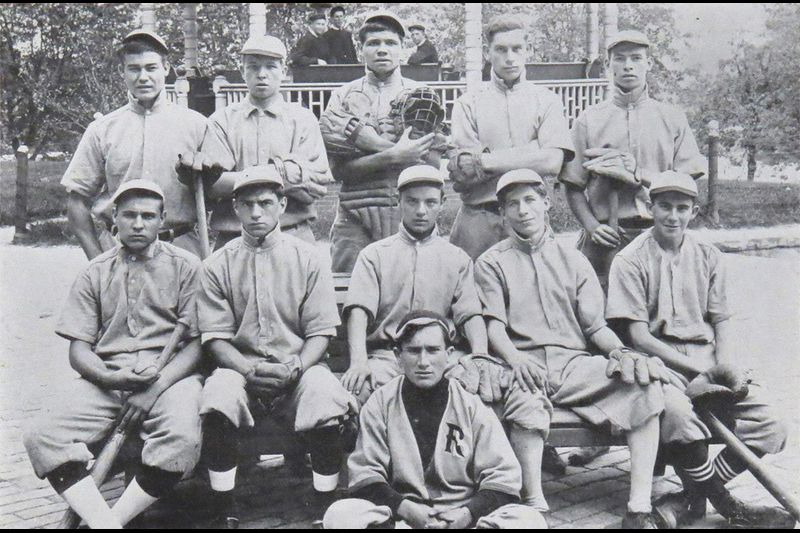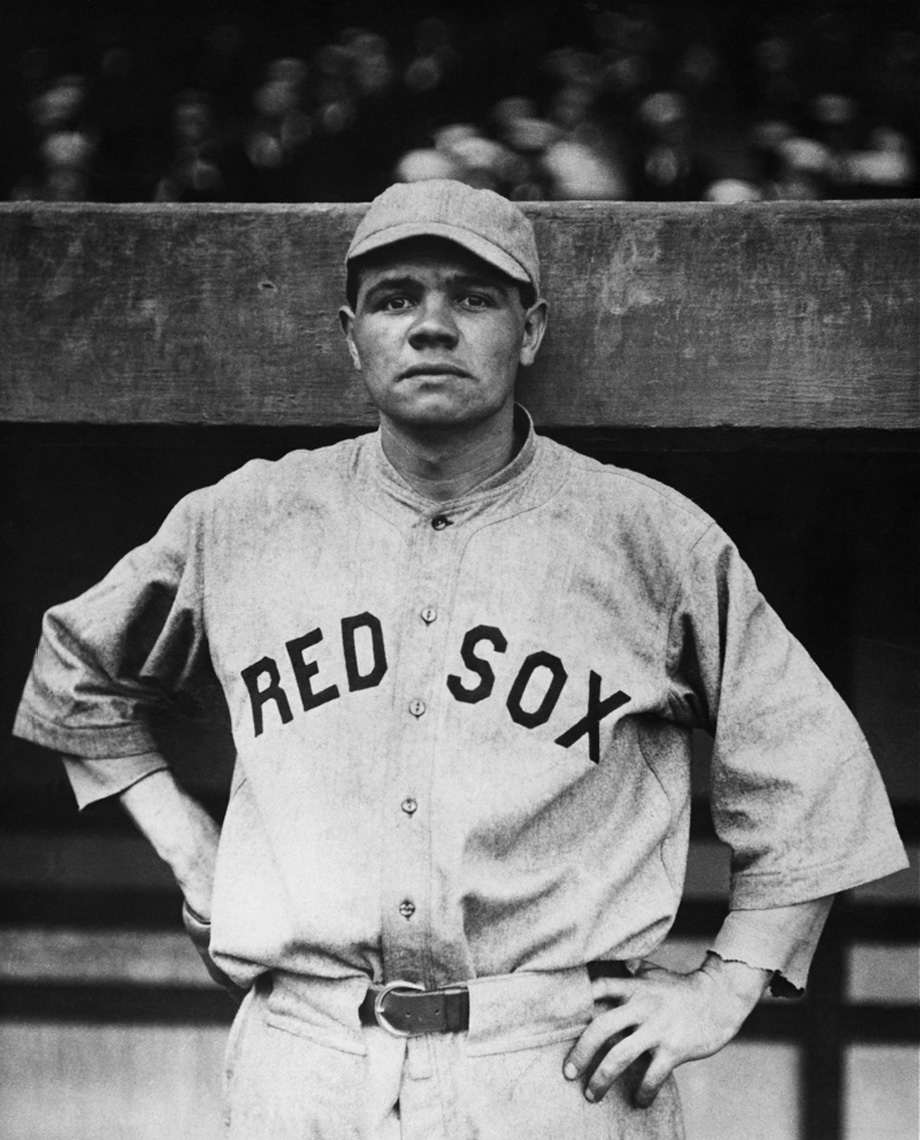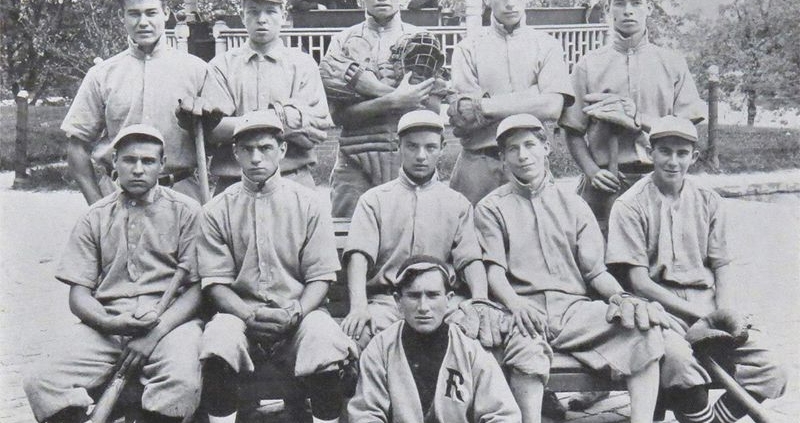Babe Ruth’s Half Season with the Baltimore Orioles in 1914
This article was written by Gary Sarnoff
This article was published in The National Pastime: A Bird’s-Eye View of Baltimore (2020)
 Babe Ruth (with catcher’s gear) pictured with his team from St. Mary’s Industrial School, and three of the Xaverian brothers who ran the school (in the gazebo). (PUBLIC DOMAIN)
Babe Ruth (with catcher’s gear) pictured with his team from St. Mary’s Industrial School, and three of the Xaverian brothers who ran the school (in the gazebo). (PUBLIC DOMAIN)
Babe Ruth began his professional baseball career in 1914 as a member of the Baltimore Orioles, a minor-league team in the International League. Long-time Baltimore Sun sportswriter Jesse Linthicum witnessed firsthand Ruth’s 19 weeks with the Orioles. “I saw Babe Ruth hit his first home run, pitch his first game and obtain the nickname of Babe,” he wrote in 1948.1
Linthicum was at St. Mary’s Industrial School in February 1914 when 19-year-old Ruth was summoned to the school’s reception room to meet Jack Dunn, the owner and manager of the Orioles. A number of Ruth’s school teammates and small kids from St. Mary’s who idolized him accompanied him to the office. Dunn, who had never seen Ruth play, had heard plenty about the school superstar — a highly-rated pitcher and hitter, capable of playing every position. He was a left-handed thrower and a switch hitter who hit .537 in 1913.
Dunn, who sought big ballplayers, liked the fact that Ruth was over six feet tall, muscular, and weighed a lean 183 pounds. After Ruth accepted Dunn’s contract offer without the slightest hesitation, the St. Mary’s ballplayers responded like a well-rehearsed chorus. “There goes our ball club,” they moaned.2
When Ruth and the Orioles arrived in Fayetteville, North Carolina, for spring training, Ruth made an immediate impression in the team’s first inter-squad game. “The youngster landed on a fastball and circled the bases before Billy Morrisette had retrieved the hit in deep right field,” a sportswriter reported.3 Linthicum called him “a prestigious clout that sent the locals down to main street talking to themselves.” As Linthicum trailed Ruth and Dunn while heading back to the hotel following the game, the writer heard Dunn say, “This Baby will never get away from me,” and according to Linthicum, “Then and there Ruth acquired the nickname of ‘Babe.’”4
Ruth began spring training as a left-handed throwing shortstop who handled all fielding chances “with ease and grace,” an observer noted.5 The observer was also impressed when he saw Ruth fan four batters in three innings in his first pitching appearance. Ruth was noted to have terrific speed, but still needed some work: “Ruth lacks one quality of a successful pitcher: He has never had experience with fast company.”6 But when he made his first pitching start of the spring exhibition season, he looked as though he was learning when he defeated the Phillies.
The next day the Orioles trailed the Phillies, 6-0, in the sixth-inning when Ruth was called in from the bullpen to put out the fire. He quickly ended the inning by whiffing Eddie Matteson and Dode Paskert and held the Phillies scoreless while his teammates chipped away at the lead and won, 7-6.
Six days later, Ruth again proved his abilities when he defeated the Philadelphia Athletics, 6-2. “Ruth, who went the full 9 innings, pitched beautifully,” wrote Jesse Linthicum. “Not at any stage of the contest did he show any signs of nervousness. The Athletics paid him a big compliment by saying he is one of the best youngsters they have seen in a long time.”7
Three days later the A’s got another crack at Ruth, and they were ready. “The Athletics started in on Ruth as though determined to drive the juvenile off the rubber,” opined a Philadelphia sportswriter.8 The first four Philadelphia batters reached base and the A’s went on to win, 12-5. Frank Baker led the A’s hitting attack by going 4-for-5. “Baker hit the ball on the nose each time and the hits shot out to the outfield like bullets,” wrote Linthicum.9
Before one of Baker’s at-bats, Orioles catcher Ben Egan told Ruth about his signal to waste a pitch. When Baker came to the plate, Egan flashed the signal to Ruth, but instead of wasting one, Ruth threw the pitch over the heart of the plate, and Baker sent the ball for a long ride. Egan then went to the mound and asked Ruth why he didn’t obey his signal. “I threw it waste high,” Ruth answered.10
 Just three months after making his professional debut with the Baltimore Orioles, Babe Ruth was sold to the Boston Red Sox and reached the major leagues on July 11, 1914. (LIBRARY OF CONGRESS)
Just three months after making his professional debut with the Baltimore Orioles, Babe Ruth was sold to the Boston Red Sox and reached the major leagues on July 11, 1914. (LIBRARY OF CONGRESS)
Not discouraged by the powerful Athletics’ rough treatment, Ruth “tossed like a million dollars” in a win over the Dodgers the following week. “In the first 5 innings, he had the visitors breaking their backs in an effort to reach his benders,” penned a Baltimore sportswriter, “and when he got himself into a hole, he showed he had the necessary backbone to pull himself together.”11 In addition to striking out six, Ruth socked a two-run triple and hit two out of the park during batting practice. “The more I see Ruth the hitter, the more I like him,” Dunn said.12 “When batting, Ruth takes a long lunge at the ball and meets it on the nose,” noted Linthicum. “He holds his bat down at the end and puts all his weight behind the swing.”13
On April 22, Ruth blanked Buffalo in his first International League start, 6-0. He yielded 6 hits and struck out 6 while going 2-for-4 at the plate. He dropped his next game, 2-1. “Ruth pitched an excellent game,” wrote Linthincum, “and should have won, 1-0. An error led to one run and a walk led to another.”14
On May 1, Ruth pitched his second win, in a relief role. With the game tied, 1-1, after nine innings, Ruth entered the game and pitched a scoreless 10th and 11th inning. In the bottom of the 11th, the Orioles had a man on first when Ruth approached the plate for his turn at bat. After taking a ball and a strike, he belted one to the left field scoreboard, far enough to allow the runner to score from first base for a 2-1 win. Ruth won his third game the next day and “again was the hero,” wrote Linthicum. “His sensational work in the box and at bat stood out as the most prominent feature.”15 He struck out seven and hit a two-run triple in an 8-3 win. He upped his record to 4-1 when he hurled 11 innings in a 5-3 win at Buffalo, but then cooled off, dropping his next two decisions.
On May 23, Dunn decided to start Ruth in right field and place him in the leadoff spot. Ruth had held his own as a shortstop in spring training, but Dunn was unsure about using a left-handed shortstop. The experiment was deemed a failure, as Ruth went 0-for 3. The next day Ruth was tagged for seven hits in 3 1/3 innings in a relief role. The humiliation from the first game did not prevent Ruth from coming back in the nightcap. Ruth pitched 11 innings in the nightcap for his fifth win of the season. He closed out the month of May with another win to up his season record to 6-3.
Ruth started June by splitting his first six decisions. On June 20, he didn’t even make it through the second inning. He was removed after yielding back-to-back home runs, one of the two hit by a first baseman named Wally Pipp. On June 23, when Ruth blanked Toronto to win his 10th, Linthicum wrote, “Ruth pitched his most brilliant game. The youngster allowed only 5 scattered hits, 2 of which were the infield variety. He had 8 strikeouts to his credit.”16 Two days later, with the Orioles trailing, 7-0, Ruth was sent in as a relief pitcher. He held the opposition and the Orioles rallied for a 13-8 win.
In his next start, Ruth allowed three runs on three hits in the first inning, but then settled down, allowing six hits in the last eight innings in a 10-5 win, his 12th of the season. On July 4, Ruth yielded two runs in the first inning. “From that point until the 7th, the visitors did not have a chance,” wrote C. Starr Matthews of the Baltimore Sun, “for Ruth twirled like the winner he is.”17 Later in the game, Ruth smacked a RBI double to help his own cause in a 4-3 win, his 13th of the season. On July 6, Ruth won in relief to up his season record to 14-7.
With the season now at its halfway point, the Orioles were in first place and appeared to be heading for the pennant. But Dunn was losing money. Fans were flocking to see the Baltimore Federals, a new major league team. Dunn entertained the thought of moving his franchise to Richmond, Virginia, but that idea was nixed by the International League, leaving him with no choice but to break up his team.
Dunn knew there would be interest for Ruth, so he offered him to his good friend Connie Mack, manager and partial owner of the Athletics. Mack was also feeling the effects of the Federal League. His attendance was down and his players were demanding new contracts mid-season, using the threat of jumping to the Federal League as leverage. “Jack, you have a great young pitcher in Ruth,” Mack told Dunn, “but I can’t give you what he is worth.”18
White Sox ivory hunter George Mills, who spent time scouting Ruth and the Orioles, made a recommendation to his boss Charles Comiskey to pay $60,000 for Ruth and five other Baltimore players. Dunn was thrilled when hearing this, but no action was ever taken. Fortunately for Dunn, another financially stable team was interested.
Boston Red Sox scout Patsy Donovan came to town and stayed a while to get a good look at Ruth. When he reported back to Red Sox owner Joseph Lannin, he highly recommended the young ballplayer. On July 6, while the Red Sox were playing in Washington, Dunn traveled to Washington to meet with Lannin. Three days later, Dunn and Lannin had a long-distance phone conference to finalize the deal. Ruth and two other Orioles were sold to the Red Sox for $25,000. “If I had made the deal in 1913, I would have made twice the amount,” said a disappointed Dunn.19 And thus concluded Babe Ruth’s brief season with the Baltimore Orioles.
GARY A. SARNOFF has been an active SABR member since 1994. A member of SABR’s Bob Davids Chapter, he has contributed to SABR’s Bio and Games Projects, and to the annual National Pastime publication. He is also member of the SABR Negro Leagues Committee and serves as chairman of the Ron Gabriel Committee. In addition, he has authored two baseball books: “The Wrecking Crew of ’33” and “The First Yankees Dynasty.” He currently resides in Alexandria, Virginia.
Notes
1 Jesse Linthicum, Baltimore Sun, “Babe Ruth, ‘a natural,’” August 17, 1948, 15.
2 Baltimore Sun, “Cree and Ruth on Job,” March 11, 1914, 5.
3 Baltimore Sun, “Home run by Ruth feature of game,” March 8, 1914,part 2, 1.
4 Jesse Linthicum, Baltimore Sun, “Babe Ruth,’ a natural,’” August 17, 1948, 15.
5 Jesse Linthicum, Baltimore Sun, “Yanigans show class,” March 14, 1914, 7.
6 Baltimore Sun, “Cree and Ruth on job,” March 11, 1914, 5.
7 Jesse Linthicum, Baltimore Sun, “Birds beat Athletics,” March 26, 1914, 5.
8 Philadelphia Inquirer, “Mackies make merry music meeting Ruth,” Sporting Section, 1.
9 Jesse Linthicum, Baltimore Sun, “Baker’s batting helps to defeat Dunn’s Orioles,” March 29, 1914, part 2, 1.
10 Jesse Linthicum, Baltimore Sun, “Babe Ruth, ‘a natural,’” August 17, 1948, 15.
11 Baltimore Sun, “Ruth beats Dodgers,” April 6, 1914, 8.
12 Jesse Linthicum, Baltimore Sun, “Orioles win in ninth,” March 19, 1914, 5.
13 Jesse Linthicum, Baltimore Sun, “Baker’s batting helps defeat Dunn’s Orioles,” March 29, 1914, part 2, 1.
14 Jesse Linthicum, Baltimore Sun, “Orioles lose both,” April 28, 1914, 7.
15 Jesse Linthicum, Baltimore Sun, “Orioles divide doubleheader with Leafs,” May 3, 1914, part 2, 1.
16 Jesse Linthicum, Baltimore Sun, “Ruth blanks Leafs,” June 24, 1914, 5.
17 Starr Matthews, Baltimore Sun, “Birds and Clams split,” July 5, 1914, part 2, 1.
18 Frederick G. Lieb, The Baltimore Orioles, (New York, G.P. Putnam’s Sons, 1955), 141-42.
19 Starr Matthews, Baltimore Sun, “The rise of Babe Ruth,” July 10, 1914, 5.


